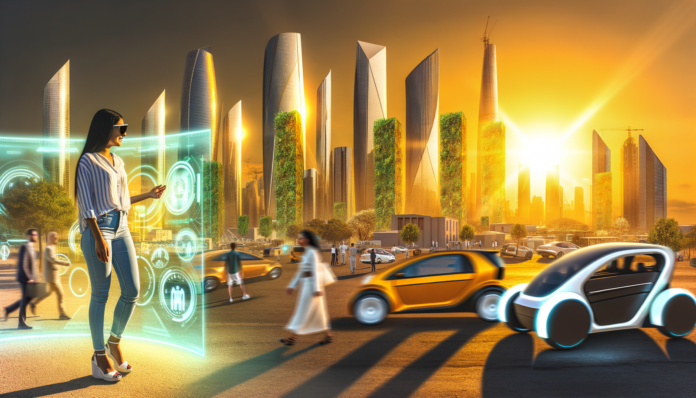Introduction
Overview of the Article
Welcome to “The Future is Bright,” an in-depth exploration of the transformative potential of solar power. This article aims to provide a comprehensive overview of the current state of solar technology, its innovations, and its far-reaching benefits. We will delve into the environmental and economic advantages of solar energy, practical applications for outdoor enthusiasts, and future trends that promise to revolutionize how we harness the sun’s power. By the end of this article, you will have a well-rounded understanding of why solar power is not just a viable alternative but a necessity for a sustainable future.
Importance of Solar Power
Solar power is more than just a renewable energy source; it is a beacon of hope in our fight against climate change and environmental degradation. The sun provides an inexhaustible supply of energy, which, if harnessed efficiently, can significantly reduce our reliance on fossil fuels. This shift is crucial for reducing greenhouse gas emissions and mitigating global warming. Moreover, solar power offers economic benefits, such as reducing electricity bills and creating jobs in the renewable energy sector. The importance of solar power extends beyond environmental and economic factors; it also plays a vital role in promoting energy independence and security.
Target Audience
This article is designed for a diverse audience, including environmental enthusiasts, technology aficionados, policymakers, and anyone interested in sustainable living. Whether you are a homeowner looking to reduce your carbon footprint, an outdoor enthusiast seeking reliable off-grid power solutions, or a policymaker aiming to implement green energy initiatives, this article has something for you. By addressing various aspects of solar power, we aim to provide valuable insights that can help you make informed decisions and contribute to a brighter, more sustainable future.
In summary, “The Future is Bright” will guide you through the current landscape of solar power, highlight groundbreaking innovations, and underscore the myriad benefits of adopting this clean energy source. Join us as we explore how solar power is lighting the way to a sustainable and prosperous future.
The Current State of Solar Power
Adoption Rates and Trends
In recent years, solar power has seen a remarkable surge in adoption worldwide. According to the International Energy Agency (IEA), global solar photovoltaic (PV) capacity more than doubled between 2015 and 2019, reaching an impressive 580 gigawatts (GW). This rapid expansion is driven by the increasing demand for renewable energy sources and heightened awareness of the environmental impacts of fossil fuels. Solar energy has become the fastest-growing source of electricity in many countries, including the United States and China.
The United States, for instance, has seen solar power become a significant contributor to new energy generation. In 2023, over half of the new energy generating capacity in the U.S. came from solar panels, marking the first time solar eclipsed 50% of yearly additions to the grid. This trend is expected to continue, with projections indicating that solar generation will increase by up to 41% in 2024.
Technological Advancements
The rapid growth in solar power adoption can be attributed to significant technological advancements that have made solar energy more efficient and cost-effective. Over the past two decades, the cost of solar cells has steadily decreased, driven by reductions in both hard costs (physical hardware) and soft costs (labor and permits). The National Renewable Energy Laboratory (NREL) notes that hard costs are now less than half of what they were in 2000, thanks to decreasing material costs and improved efficiency in light capture.
One of the most notable advancements is the development of high-efficiency solar cells, such as monocrystalline and polycrystalline silicon cells, which convert a higher percentage of sunlight into electricity. Additionally, thin-film solar panels, which are lightweight and flexible, have emerged, enabling integration into various surfaces, including building facades and vehicles.
Another breakthrough is the integration of energy storage systems, such as batteries, with solar installations. These systems store excess electricity generated during peak sunlight hours, ensuring a reliable and consistent energy supply even during periods of low solar irradiation. This advancement addresses the intermittent nature of solar power and enhances grid stability when coupled with smart grid technologies.
Challenges and Limitations
Despite the impressive advancements and adoption rates, solar power still faces several challenges and limitations. One of the primary challenges is the intermittency of solar power, as it is dependent on sunlight availability. This poses a limitation for regions with limited sunlight or during nighttime hours when solar panels do not generate electricity.
Grid integration is another significant challenge. The existing electrical infrastructure may not be equipped to handle high penetrations of solar energy. The intermittent nature of solar power requires the grid to balance supply and demand efficiently, necessitating the development of sophisticated grid management systems and energy storage technologies to ensure a stable and reliable electricity supply.
Additionally, the production and disposal of solar panels present environmental challenges. The manufacturing of solar panels requires the extraction of raw materials, such as silicon and metals, which can have a significant environmental impact. Furthermore, the disposal of end-of-life solar panels raises concerns about proper recycling and waste management practices to prevent environmental contamination.
In conclusion, while the current state of solar power is marked by rapid growth and technological advancements, it is essential to address these challenges to ensure the continued expansion and integration of solar energy into the global energy mix.
Innovations in Solar Technology
Portable Solar Solutions
The advent of portable solar solutions has revolutionized the way we harness solar energy, making it more accessible and versatile than ever before. These innovations are particularly beneficial for outdoor enthusiasts, emergency responders, and those living in remote areas. **Portable solar panels** and **solar chargers** are now lightweight, compact, and highly efficient, allowing users to power devices on the go. Companies like Sunflare have developed thin, flexible panels that can be easily attached to various surfaces, including backpacks, tents, and even clothing. This flexibility ensures that solar power can be utilized in a wide range of environments, from urban settings to the most rugged outdoor terrains.
Efficiency Improvements
One of the most significant advancements in solar technology is the dramatic improvement in solar panel efficiency. In the early days, solar panels had a conversion efficiency of around 10%, but today, efficiencies exceeding 20% are common, with some experimental designs reaching up to 46%. This leap in efficiency is largely due to the development of **multi-layered solar cells** and the use of new materials like perovskites. Perovskite solar cells, in particular, have shown great promise due to their high efficiency and low production costs. Additionally, innovations such as **bifacial solar panels**, which capture sunlight from both sides, and **anti-reflective coatings** that minimize light loss, have further enhanced the performance of solar panels.
Integration with Smart Technologies
The integration of smart technologies with solar panels is transforming the way we generate and manage solar energy. **Smart solar panels** equipped with sensors and Internet of Things (IoT) capabilities allow for real-time monitoring and optimization of energy production. These panels can adjust their orientation to track the sun, ensuring maximum exposure and efficiency. Moreover, the use of **artificial intelligence (AI)** in solar energy systems enables predictive maintenance and energy management, reducing downtime and improving overall system performance. For instance, AI algorithms can analyze weather patterns and energy consumption data to optimize the storage and distribution of solar energy, making it a more reliable and efficient power source.
In conclusion, the innovations in solar technology are making solar power more portable, efficient, and intelligent. These advancements not only enhance the usability and performance of solar panels but also pave the way for a more sustainable and energy-efficient future. As we continue to explore and develop new technologies, the potential for solar energy to become a dominant force in the global energy landscape looks increasingly promising.
Environmental and Economic Benefits
Reducing Carbon Footprint
The transition to solar power is a significant step towards reducing our carbon footprint. Traditional energy sources, such as coal and natural gas, release substantial amounts of carbon dioxide (CO2) and other greenhouse gases into the atmosphere, contributing to global warming and climate change. Solar power, on the other hand, generates electricity without emitting CO2 or other harmful pollutants. By harnessing the sun’s energy, we can significantly cut down on the emissions that are driving climate change.
Moreover, the adoption of solar power aligns with global efforts to meet climate targets set by international agreements like the Paris Agreement. As more households, businesses, and governments switch to solar energy, the cumulative reduction in greenhouse gas emissions can have a profound impact on mitigating climate change. This shift not only helps in preserving the environment but also promotes a healthier planet for future generations.
Cost Savings Over Time
One of the most compelling economic benefits of solar power is the potential for significant cost savings over time. While the initial investment in solar panels and installation can be substantial, the long-term savings on energy bills can outweigh these upfront costs. Solar panels have a lifespan of 25-30 years, during which they can provide free electricity after the initial payback period, which typically ranges from 5 to 10 years depending on various factors such as location, energy consumption, and available incentives.
Additionally, many governments and local authorities offer incentives, tax credits, and rebates to encourage the adoption of solar energy. These financial incentives can further reduce the initial costs and make solar power more accessible to a broader audience. Over time, as technology advances and production scales up, the cost of solar panels continues to decrease, making solar energy an increasingly cost-effective solution.
Supporting Sustainable Living
Solar power is a cornerstone of sustainable living, offering a renewable and inexhaustible source of energy. Unlike fossil fuels, which are finite and deplete over time, solar energy is abundant and available everywhere the sun shines. By integrating solar power into our daily lives, we can reduce our dependence on non-renewable energy sources and promote a more sustainable and resilient energy system.
Furthermore, solar power supports sustainable living by encouraging energy independence. Homeowners and businesses with solar panels can generate their own electricity, reducing their reliance on the grid and enhancing energy security. This decentralization of energy production can also lead to more stable and resilient energy systems, less vulnerable to disruptions and price fluctuations associated with fossil fuels.
In conclusion, the environmental and economic benefits of solar power are substantial. By reducing our carbon footprint, achieving cost savings over time, and supporting sustainable living, solar energy presents a viable and attractive solution for a brighter and more sustainable future.
Practical Applications for Outdoor Enthusiasts
Camping and Hiking
For outdoor enthusiasts, camping and hiking are quintessential activities that offer a direct connection to nature. Solar technology has revolutionized these experiences by providing reliable and sustainable energy solutions. Portable solar panels and solar-powered chargers are now essential gear for campers and hikers. These devices can power essential gadgets like GPS units, smartphones, and even small cooking appliances, ensuring that adventurers stay connected and safe while off the grid.
Moreover, solar-powered lanterns and flashlights have become popular, offering a renewable source of light that reduces the need for disposable batteries. This not only lightens the load but also minimizes environmental impact. Solar backpacks, equipped with built-in panels, allow hikers to charge their devices on the go, making it easier to navigate and document their journeys.
Boating and Marine Use
Solar power is also making waves in the boating and marine sectors. Solar panels can be installed on boats to provide a steady supply of electricity, reducing the reliance on fuel and lowering operational costs. This is particularly beneficial for long voyages where access to traditional power sources is limited.
Solar-powered desalination units are another innovative application, converting seawater into drinkable water using solar energy. This technology is a game-changer for sailors and marine adventurers, ensuring a sustainable supply of fresh water without the need for bulky storage tanks. Additionally, solar-powered navigation lights and communication systems enhance safety and reliability, making marine adventures more enjoyable and eco-friendly.
Off-Grid Living
For those who seek a more permanent escape from urban life, off-grid living offers a sustainable and self-sufficient lifestyle. Solar power is a cornerstone of this way of life, providing a reliable and renewable source of energy. Solar panels can power entire homes, from lighting and heating to appliances and water pumps, making it possible to live comfortably without relying on traditional power grids.
Solar water heaters and solar cookers are also popular among off-grid enthusiasts, offering efficient and eco-friendly alternatives to conventional methods. These technologies not only reduce carbon footprints but also lower utility costs, making off-grid living more affordable and sustainable.
In addition, solar energy storage solutions, such as solar batteries, ensure that power is available even during cloudy days or at night. This reliability is crucial for those living in remote areas where access to emergency services may be limited.
Overall, the integration of solar technology into outdoor activities and off-grid living not only enhances the experience but also promotes a more sustainable and environmentally friendly lifestyle. As solar technology continues to advance, its applications for outdoor enthusiasts will only expand, making the future indeed bright.
Future Trends and Predictions
Emerging Technologies
The future of solar power is set to be revolutionized by a host of emerging technologies. One of the most promising advancements is the development of perovskite solar cells. These cells offer higher efficiency rates and lower production costs compared to traditional silicon-based cells. Additionally, innovations in solar panel materials, such as organic photovoltaics and tandem cells, are expected to further enhance efficiency and flexibility.
Another exciting development is the integration of solar technology with artificial intelligence (AI) and machine learning. These technologies can optimize energy production by predicting weather patterns and adjusting the angle of solar panels in real-time. Moreover, AI can help in the maintenance of solar farms by identifying potential issues before they become significant problems.
Market Growth Projections
The solar power market is poised for substantial growth in the coming years. According to industry analysts, the global solar energy market is expected to grow at a compound annual growth rate (CAGR) of over 20% from 2023 to 2030. This growth is driven by increasing government incentives, declining costs of solar technology, and a growing awareness of the need for sustainable energy solutions.
Regions such as Asia-Pacific and North America are expected to lead this growth due to their favorable policies and significant investments in renewable energy infrastructure. In particular, countries like China and India are making substantial strides in expanding their solar capacities, aiming to reduce their reliance on fossil fuels.
Potential Challenges
Despite the optimistic outlook, the future of solar power is not without its challenges. One of the primary obstacles is the intermittency of solar energy. Since solar power generation is dependent on sunlight, it can be inconsistent, especially in regions with variable weather conditions. This necessitates the development of efficient energy storage solutions to ensure a stable power supply.
Another challenge is the initial cost of solar installations. Although the long-term savings are significant, the upfront investment can be a barrier for many consumers and businesses. Financial incentives and innovative financing models, such as solar leasing and power purchase agreements (PPAs), are essential to mitigate this issue.
Lastly, the disposal and recycling of solar panels pose environmental concerns. As the number of solar installations increases, so does the volume of end-of-life panels. Developing sustainable recycling methods and policies will be crucial to address this issue and ensure the long-term viability of solar power.
In conclusion, while the future of solar power is bright with numerous technological advancements and market growth, addressing these challenges will be key to realizing its full potential.
Conclusion
Summary of Key Points
Throughout this article, we have explored the promising future of solar power and its transformative potential. We began with an overview of the importance of solar energy and its growing adoption rates. We delved into the current state of solar power, highlighting technological advancements and the challenges that still need to be addressed. Innovations in solar technology, such as portable solar solutions and efficiency improvements, were discussed, showcasing how these advancements are making solar power more accessible and effective. We also examined the environmental and economic benefits of solar energy, emphasizing its role in reducing carbon footprints, providing cost savings, and supporting sustainable living. Practical applications for outdoor enthusiasts were highlighted, demonstrating how solar power can enhance activities like camping, boating, and off-grid living. Finally, we looked at future trends and predictions, including emerging technologies and market growth projections.
Encouragement for Adoption
The future of solar power is undeniably bright, but its success depends on widespread adoption and continued innovation. As individuals, communities, and businesses, we have the power to drive this change. By investing in solar technology, we can contribute to a more sustainable and economically viable future. Governments and policymakers also play a crucial role in supporting solar initiatives through incentives and regulations that encourage the use of renewable energy. Educational institutions can help by integrating solar technology into their curricula, preparing the next generation to be knowledgeable and passionate about renewable energy solutions.
Final Thoughts
In conclusion, solar power represents a beacon of hope in our quest for a sustainable and environmentally friendly future. The advancements in technology and the increasing adoption rates are promising, but there is still much work to be done. By embracing solar power, we can reduce our reliance on fossil fuels, lower our carbon footprint, and create a more resilient and sustainable world. The journey towards a solar-powered future is a collective effort that requires the participation and commitment of individuals, businesses, and governments alike. Let us seize this opportunity to make a positive impact and ensure that the future is indeed bright.






